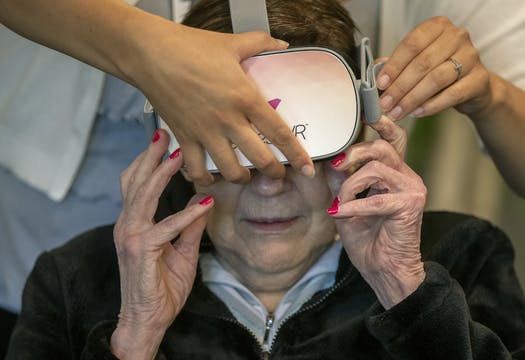Virtual reality lets seniors travel without leaving home
Virtual reality lets seniors travel without leaving home
A stream wound through a forest with snowy mountains beckoning in the background. The water looked so refreshing that Kathy Boone wanted to dip a toe in, so she kicked off a shoe.
“Whoo, I love it!” said Boone, 68. “Anybody else want to go barefoot?”
Shorewood Landing, a senior-housing center in Shorewood, is far from the nearest snow-capped peaks. But on Tuesday, half a dozen residents visited Rocky Mountain National Park via virtual reality (VR), a technology that presents realistic sounds and three-dimensional scenes.
The residents — most of them in memory care — donned headsets and could hear the stream flowing, gaze 360 degrees around the forest, and look up and see blue sky.
Bill Hurrell, 92, spotted a group of anglers by the stream. “I like her fishing outfit!” said Hurrell, 92. “I just wish they had better focus on it — it looks pretty good.”
WellnessVR is produced by a Minneapolis-based company called Visual. Its VR programming for senior residences is a blend of entertainment and therapy, said Chuck Olsen, founder and CEO.
After leaving the mountain stream, residents virtually visited the Ordway Center in St. Paul to watch part of an opera. One woman in the group, a former professional opera singer, sang along. From there it was off to a beach in the Florida Keys where, hearing the waves, some residents said they felt like jumping in.
VR can capture memory-care patients’ attention longer than traditional senior-living programming such as music or bingo. Afterward, the lunchroom is abuzz with residents describing what they’d seen. On Tuesday, a particularly active woman remained seated about twice as long as she usually does. “I have never seen her this engaged in anything before,” said Nadia Smith, activities director.
Grandparents can brag to their grandkids, Olsen said, about having an adventure even many millennials haven’t experienced.
WellnessVR is one of several programs around the country providing such therapy, Olsen said. In 2017, it partnered with Minneapolis-based Ebenezer Senior Living to study therapeutic benefits. In questionnaires before and after the experience, 96% of participants reported feeling happier, 97% more relaxed and 94% less worried.
“The mood changes carried over after the session,” said Joel Prevost, director of outreach and engagement with Visual.
University of Washington researchers found that, for burn victims, VR visits to snowy landscapes were more effective than morphine in relieving excruciating pain. Other potential uses include virtual field trips for young students and academic researchers, Olsen said.
Tim Knopik, 74, of Shorewood Landing, said he’d like to take a virtual trip to Las Vegas — specifically to the first floor of Binion’s Gambling Hall on a Saturday night.
That particular scene might not be on the agenda but Olsen said “we do take requests” and keep a record of them.
Although WellnessVR’s programs aren’t currently tailored to residents’ specific needs, its library of 63 experiences includes scenes such as Minnehaha Falls and close-up farm animals, designed to appeal to aging Minnesotans. A program called “Grandmother’s Porch” involves an old-fashioned (computer generated) porch. But someday VR could feature people’s actual grandmothers’ actual porches. Individualized VR programs could take people to their hometowns or to visit their grandchildren — someday even providing two-way live interaction among family members.
“Virtual reality can be both a travel machine and a time machine,” Olsen said.
Anita Cornelius, regional assisted living director at Ebenezer, said memory care residents don’t always recall their VR experiences afterward.
But that’s OK, she said, because for people with memory loss, recalling the past isn’t as important as enjoying the present. “Their experiences are moment to moment. That’s where their life is.”

Media Inquires Contact: [email protected]
